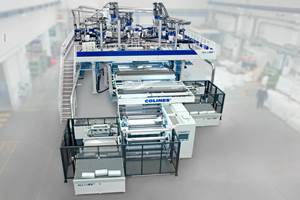A Challenger Tackles Coinjection For Barrier PET Preforms
Barrier PET containers for beverages, sauces, and other sensitive products become more cost-effective through more efficient use of expensive barrier resins.
One of the more dramatic announcements at NPE2015 later this month in Orlando, Fla., will be the unveiling of a new barrier coinjection technology for PET preforms by Husky Injection Molding Systems Ltd., Bolton, Ont. Although it will not be running at the show, the entry of Husky into this field poses new competition for existing barrier coinjection technology that will be demonstrated in Orlando by Milacron LLC, Cincinnati (see NPE injection preview on p.62). Nicolas Rivollet, Husky’s director of business development, recently explained to Plastics Technology Husky’s goals for its multilayer preform technology.
CHANGING THE COST PICTURE
As Rivollet put it, Husky’s intent is “to change the business case for multilayer preforms” as a solution to PET barrier container needs for foods and beverages. “There’s nothing revolutionary in the technology, but our level of performance is unique.” According to Rivollet, the “make or break” challenge is to “distribute minute amounts of barrier material—in some cases, as little as 0.25 g or 2%—very uniformly. “We’re talking about only 20 to 25 pellets of barrier material in a 15-20 g preform,” he says. The barrier could be EVOH or nylon sandwiched between inner and outer layers of PET; or, in the case of milk bottles, a black HDPE layer could provide light barrier between two white HDPE layers.
Husky has worked in the past with Kortec (recently acquired by Milacron), supplying the injection machine for Kortec’s turnkey barrier coinjection systems. Now Husky is proceeding on its own to offer a module for its HyPET HPP5 preform system, which includes a multi-channel coinjection nozzle, small side-mounted secondary injection unit, and the mold with hot-runner system. Husky is starting out with 48 cavities and will later add 72 and 96 cavities.
Rivollet said Husky saw “room for improvement in the ability to control the total amount and distribution of expensive barrier material both between cavities and within each individual preform. One typically targets 5% barrier content, but when we measured the actual result, we found it ranged between 4% and 6.5% of total preform weight.” He said that 5% ± 1.5% variation “is very common and a pretty wide bandwidth.” He further noted that with current technology, “You can reduce that somewhat with highly trained operators and frequent stops and tweaks.”
Rivollet claims that Husky’s new module built on the HyPET HPP5 platform can reduce cavity-to-cavity and shot-to-shot variation in barrier content to ± 0.5%, which can lead to cost savings of as much as 50% in barrier material. “We can achieve the same average barrier content, but with lower quality risk,” he said. “The real question is what is the minimum barrier content that you need. If it’s 4%, then today, with a low-capability system, you would have to set your average at 6.3% to ensure no more than 100 ppm of preforms would go below target. With our high-capability technology, you could set your target at 4.5% with a narrower tolerance band. At $9000/ton for barrier resin, that has a big impact on total cost.”
The melt delivery system is the key to this achievement, Rivollet explains. It includes Husky’s valve-gate hot-runner system with new advances that achieve 50% tighter balance between cavities than Husky’s current conventional hot runner, which the firm says is already “best in class.” Said Rivollet, “We utilized a different concept that reduces the number of splits in the melt and special melt channels that reduce temperature differences between cavities. The result is better thermal balance and lower pressure drop.” And unlike other systems, he added, all the nozzle tips are accessible from the front for easier maintenance.
Although data is still being collected from R&D studies, Rivollet said preliminary results indicate that Husky’s barrier module also achieves more uniform distribution of barrier resin within each preform. Husky is working on measuring devices that can see through the thickness of the preform for non-destructive measurement of the barrier layer. “Our nozzle design helps,” he said, “by providing better control of the leading and trailing edges of the barrier-layer melt during injection.”
While officially introducing its barrier concept at NPE, Husky will not be running a demonstration at the show, though it may have some preform samples on hand. However, the barrier module is based on Husky’s latest-generation HyPET HPP5 system for PET preforms, which will be running at the booth. Rivollet says the cycle time and machine availability of the barrier module are exactly the same as for the HPP5 with monolayer preforms.
Related Content
Young Stretch-Film Processor Bets on Nanolayers
Going up against companies with as much as double its capacity, young stretch-film processor Zummit believes that new technology — notably 59-nanolayer films — will give it a competitive edge.
Read MoreHow to Extrusion Blow Mold PHA/PLA Blends
You need to pay attention to the inherent characteristics of biopolymers PHA/PLA materials when setting process parameters to realize better and more consistent outcomes.
Read MoreHow to Optimize Injection Molding of PHA and PHA/PLA Blends
Here are processing guidelines aimed at both getting the PHA resin into the process without degrading it, and reducing residence time at melt temperatures.
Read MoreFoam-Core Multilayer Blow Molding: How It’s Done
Learn here how to take advantage of new lightweighting and recycle utilization opportunities in consumer packaging, thanks to a collaboration of leaders in microcellular foaming and multilayer head design.
Read MoreRead Next
Advanced Recycling: Beyond Pyrolysis
Consumer-product brand owners increasingly see advanced chemical recycling as a necessary complement to mechanical recycling if they are to meet ambitious goals for a circular economy in the next decade. Dozens of technology providers are developing new technologies to overcome the limitations of existing pyrolysis methods and to commercialize various alternative approaches to chemical recycling of plastics.
Read MoreTroubleshooting Screw and Barrel Wear in Extrusion
Extruder screws and barrels will wear over time. If you are seeing a reduction in specific rate and higher discharge temperatures, wear is the likely culprit.
Read More

















.png;maxWidth=300;quality=90)









